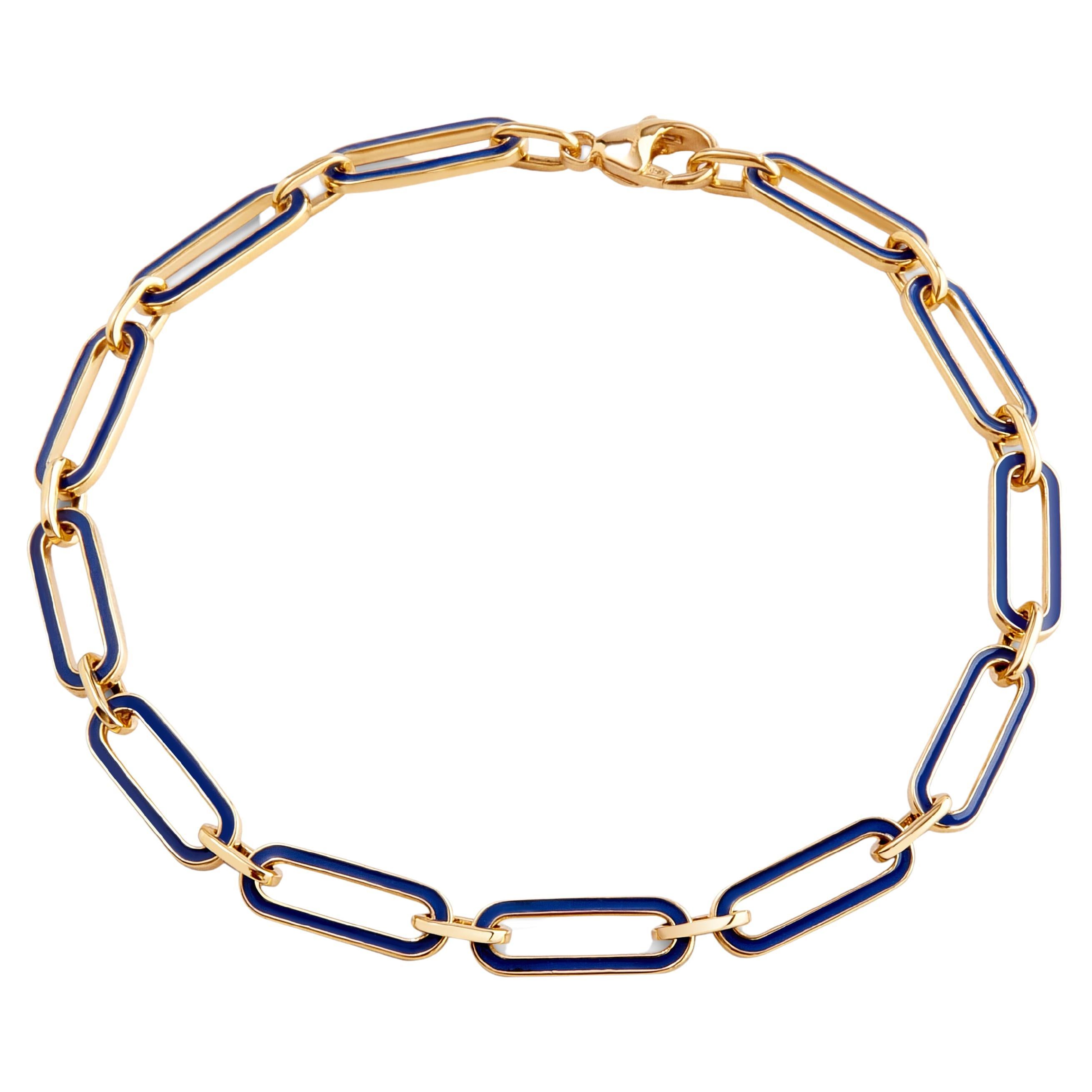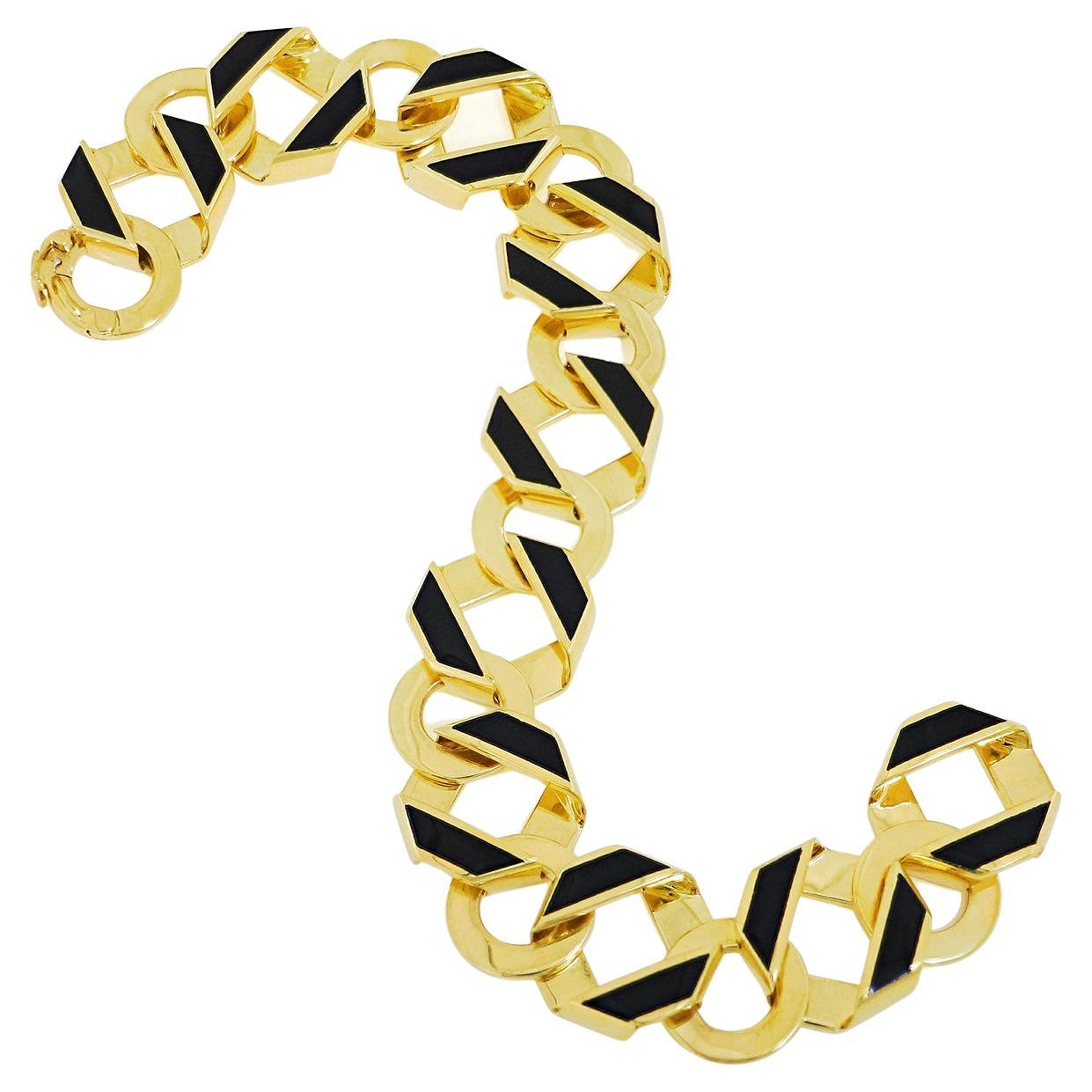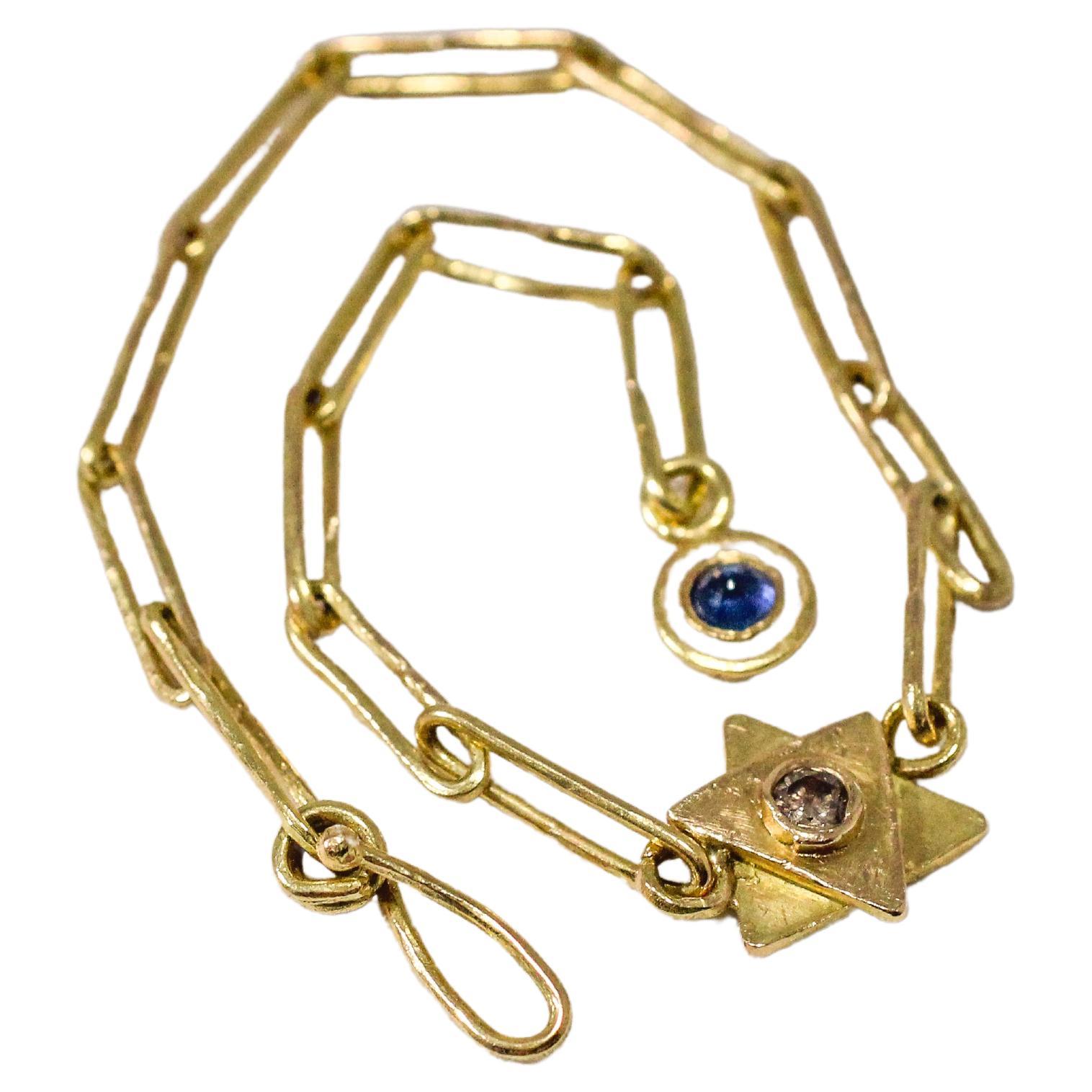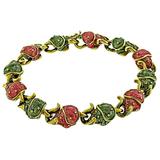Items Similar to Polychrome Enamels "Moretti" Gold Bracelet
Want more images or videos?
Request additional images or videos from the seller
1 of 7
Polychrome Enamels "Moretti" Gold Bracelet
About the Item
Rare gold bracelet with "moretti" made in polychrome enamels. An oval-cut Bohemian garnet is enclosed in the center of each sector.
Refined creation of the Dalmatian workshop of the goldsmith artist Rodolfo Giraldi, active also in New York till the Sixties.
Historical notes:
The Moretto was born in Rijeka as a gold and silver earring as an amulet, which soon became a symbol and strong testimony of Rijeka identity.
The Turkish threat and the much feared pirate attacks could be at the origin of the vast diffusion of the Moor's head motif in Dalmatia, in the Adriatic cities, on the islands and in southern Italy, not only in the form of a ring but also as a noble coat of arms. Wearing the moretto was perhaps a way to exorcise fear; the populations of the coast also provided to donate them to the churches in moments of ceased danger. The Turkish threat was a relevant matter for the northern Adriatic especially in the fifteenth century. and ceased definitively only in 1699, after the victory of the Holy League (Peace of Carlowitz).
Legend about the Fiuman origin of the Moretti dates back to the Tartar invasion of 1242. It was reported by Riccardo Gigante (son of the goldsmith Agostino, an Italian irredentist) who writes that in 1242 the Tartars who had invaded Hungary, went down to the sea in pursuit of the fugitive King Bela IV and stopped a few kilometers from Fiume, on the field of Grobnico, which was then entirely covered by the waters of a lake, threatening the city with massacre. The rivers, powerless to stem the advance of the marauders, turned their prayers to heaven to implore their help. The sky was not deaf to their cry of anguish, it struck them with a terrible hail of stones, which killed them and buried them all up to their necks, leaving only their heads exposed and almost completely filled the lake". Legend has it that, to commemorate this incredible event, the field was renamed "Field of stones" and the inhabitants of Fiume made gold earrings in the shape of a dark brown for their women.
Beyond the legends, men and women of Fiume began to wear dark brown earrings to protect themselves and drive away evil forces; it is said that they were particularly widespread among fishermen and sailors as they could have been sold in case of need or shipwreck to return home. In ancient times it was customary to give the earring with the moretto to the male children; this piece of costume jewelery was a symbol of great class. Moretti were also given to churches as votive gifts.
From the consultation of the documents of the 1700s it can be deduced that these moretti were forged by the goldsmiths rivers with simple and practical gold and silver earrings, partially covered by black enamel on the
head and chest. Another characteristic sign was the white turban with flaps and dots. The nineteenth century
saw the spread of a new model, the Turkish, characterized by curved gold stripes and dots
black and gold on the white turban. In the second half of the century these jewels were more
elaborated and decorated and took on different forms (rings, bracelets, pendants, brooches, decorative cutlery
etc.). If the women in mourning preferred the simple forms of moretti blacks, devoid of ornaments and
decorations, all the others were made brooches and earrings adorned with corals and other stones,
modifying the number and size of the heads to their liking.
Fiume, with its famous Morettisti and the
their art, thus became the most important center for the processing of this jewel, and to the "Moors", so
as they were called, the adjective “fiumani” was added as an expression of autochthony.
The history of the Moretto Fiume must necessarily also pay homage to those who made it so important by making it known throughout the world, especially between the end of the 19th century and the early 1900s: the goldsmiths from Fiume. Giovanni Corossacz, a goldsmith active since 1835, was the first to apply moretto on brooches, bracelets, jugs and necklaces. A fundamental moment for the development of the production of moretti in Fiume and their diffusion throughout the world was certainly the high commission received from the Empress Maria Anna, daughter of Vittorio Emanuele I of Savoy. Corossacz created a beautiful specimen, according to the dictates and wishes of the Empress, of extraordinary success; after that he started to create new models following his creative flair. The Morettos experienced an incredible diffusion in Istria, on the Kvarner islands and on the rest of the Adriatic, in Gorski Kotar and in Vinodol up to the territory of Castua and Grobnico. The goldsmith Agostino Gigante contributed significantly to their success; his shop in Piazza del Duomo was immediately appreciated for its innovation, expertise and originality. The company "Gigante e Co" obtained numerous prizes: Industrial Exhibition of Budapest (1885); Brussels World Exhibition (1888); Budapest Millennium Exhibition (1896); Brussels International Exhibition (1897); First industrial exhibition in Rijeka (1899); Universal Exposition of Paris (1900); London Colonial and Indian Exhibition (1905). Having become a supplier to the Imperial Court, Gigante put the Archduke's coat of arms on the business cards and billboards of his goldsmith's shop. The precious enamels also arrived from Vienna, which made it possible to transform a goldsmith's object into a real jewel. The Gigantes were a serious firm, well aware of the refinement of their work which was done by hand, without resorting to machines. After Agostino's death, in 1925 the "Gigante e Co" closed the business and the Giraldi spouses bought the equipment for the processing of moretti and a precious catalog of 1880, to continue the art of the moretto drawing inspiration from the shapes and from the original techniques. Still today in Fiume the Morettisti show great respect and devotion for this catalogue, a precious volume that contains designs of jewels of extremely fine workmanship, in which the set of moretti juxtaposed, aligned or intertwined, allows for the creation of geometric games and precious laces. Precious ideas from which necklaces, diadems, tableware, earrings, necklaces, pendants, etc. are born. The Giraldis had a shop in P.zza delle Erbe since 1911; after his father's death in 1929, Rodolfo (born in 1913) took up the goldsmith's art and ran the business until 1948, when he moved as an exile to Desenzano sul Garda (Verona) for political reasons, given the hostility of the regime di Tito against him (many jewels and a large part of his equipment had been seized in Fiume). In Desenzano, according to Giraldi himself, the moretto was somewhat overlooked because it was a niche jewel, difficult to offer to a wider audience. In 1956, however, Rodolfo emigrated to the USA and resumed the production of moretti, as a matter of tradition and personal love, in the New York jewelry store where he was employed, making dark brown heads for Fiume residents in America. Giraldi, the Moretti goldsmith par excellence and a true symbol for the people of Fiume, has always continued to participate in the numerous gatherings of Fiume citizens around the world.
THE PROCESSING TECHNIQUES
Testimony of the goldsmith Raul Rolandi, released to Radmila Matejcic: “The shape for the skeleton of the Moretto, its head and the bust, is positively imprinted in the cuttlefish bone cut lengthwise. From this positive the negative is then obtained in which the molten gold is poured. When gold becomes solid, the gold positive is obtained. The surface of the positive is smoothed with files and small knives so that the enamel can be applied, reduced to a fine powder in a mortar. This powder is poured into nitric acid in which it remains for two hours, rinsed and then dried. On a small piece of glass, the enamel is mixed with a little water. This paste is applied with a needle on the gold skeleton, previously cleaned of residues of chloric acid accumulated during the process of faceting and applying the ornaments. When you put enamel on the skeleton you shape the head. In particular, the arches for the earlobe are imprinted, then the plastic of the nose and chin is highlighted. Three golden dots are visible and represent the eyes and lips. The model is then placed in a small oven in the shape of a cylinder cut lengthwise. The oven is then placed in the so-called "windoffen", covered with charcoal and left until it becomes red-hot. Then you remove it, let it cool for 10 minutes and take out the support with the moretti. This process is first hand glazing. The second coat is more precise, the shape of the head is perfected, the channels are cleaned and any holes in the enamel are filled. Then the nose is shaped and the black dots are put on the white turban. The model goes back into the oven; when you take out the gold it is black therefore the moretto is put in the mild solution of hydrochloric acid so that it becomes white. After having been rinsed, the Moretto is cleaned with nail files and 5lustrated with emery paper or with a brush. Further work depends on the model and type of jewelry; the moretto's skeleton can be in bronze, silver or gold and precious and semi-precious stones, corals, pearls, etc. can be added”. Testimony of Rodolfo Giraldi: "The procedure is as follows: you take the shape, I still use those of the Giant, and prepare the mold in the cuttlefish bone, work the moretto melted in gold and then apply the enamel which it should be rolled out and then baked in the oven, for one, two, three or four “fornade”. Once the ovens worked with coal, now electric ones are used and the result changes slightly. We then move on to cleaning and sanding. When ready, it is embellished with coral, ruby or other stone. But, at this point, it's not finished yet, it's the details that make the difference. There are moretti with earrings and without, with precious and simple stones, in short, it depends on the request of the buyer and on the imagination of the creator”. The greatest challenge for today's morettistic production is represented by the defense of traditional manufacturing techniques.
- Creator:Rodolfo Giraldi
- Metal:
- Stone:
- Stone Cut:
- Weight:45.97 g
- Dimensions:Width: 0.67 in (17 mm)Depth: 0.12 in (3 mm)Length: 7.88 in (200 mm)
- Style:
- Place of Origin:
- Period:
- Date of Manufacture:1930
- Condition:Avery rare and hystorical piece of art. Read on my blog about the "moretto"!
- Seller Location:Sežana, SI
- Reference Number:1stDibs: LU2481218844042
About the Seller
5.0
Vetted Seller
These experienced sellers undergo a comprehensive evaluation by our team of in-house experts.
Established in 1996
1stDibs seller since 2022
Typical response time: 17 hours
- ShippingRetrieving quote...Ships From: Sežana, Slovenia
- Return PolicyA return for this item may be initiated within 3 days of delivery.
More From This SellerView All
- Blue Enamelled Diamonds RingLocated in Sežana, SIRounded ring in 18K white gold, blue enamelled. It bears 7 natural brilliant-cut diamonds, for a total weight of over 3 ct. Excellent color and purity It...Category
Vintage 1950s Italian Modernist Cocktail Rings
MaterialsDiamond, Gold, 18k Gold, Enamel
- Raro bracciale art deco con diamanti, oltre 28 ct. Impero AustroungaricoLocated in Sežana, SIMeraviglioso bracciale di produzione austroungarica (Vienna), circa 1910. Reca diamanti naturali per un peso complessivo di oltre 28 ct. Sono presenti una pietra centrale da ct. 1,98...Category
Vintage 1910s Austrian Art Deco Link Bracelets
MaterialsDiamond, White Gold
- Russian XIX Century Gold Chain BraceletLocated in Sežana, SIGorgeous bracelet produced in St. Petersburg, period zar Alexander II 14K Gold Secret vane on the center clasp box, elegantly enameled and enriched with diamonds Lenght cm 22 Weight ...Category
Antique 1850s Russian Russian Empire Retro Bracelets
MaterialsDiamond, 14k Gold, Yellow Gold, Gold
- Huge diamonds braceletLocated in Sežana, SIThis stunning piece features a central line of 40 dazzling diamonds, each weighing 0.12 carats, accompanied by two external lines of 80 sparkling diamonds, each weighing 0.02 carats. Diamonds' total weight ct. 6,40! Average color: I/J Average clarity: VVS2/Vs1 Crafted with love and precision in Italy during the swinging Sixties...Category
Vintage 1950s Italian Modern Tennis Bracelets
MaterialsDiamond, 18k Gold, White Gold
- Pivoting gold rhombus pendantLocated in Sežana, SIElegant pendant in the shape of a rhombus, made of yellow 18K gold On one side No. 83 brilliant cut diamonds, estimated weight of ct. 0.02 each. On the opposite side No. 40 sapphires...Category
Vintage 1970s Italian Contemporary Pendant Necklaces
MaterialsDiamond, Emerald, Ruby, Sapphire, Gold, 18k Gold
- Yellow Gold Daisy RingLocated in Sežana, SISumptuous 18K yellow gold daisy ring. It bears natural brilliant cut diamonds for a total weight of 3 carats. Italian production of the 60s. We...Category
Vintage 1960s Italian Artisan Cocktail Rings
MaterialsDiamond, Yellow Gold
You May Also Like
- Fold Over White Enamel 18K Yellow Gold Chain Link BraceletBy Valentin MagroLocated in New York, NY18k yellow gold and white enamel join together to bring a glow for this bracelet. An intertwined pattern of flattened hexagonal strips alternate with flat discs. The hexagonal strips...Category
2010s Contemporary Link Bracelets
Materials18k Gold, Yellow Gold, Gold, Enamel
- Syna Yellow Gold Geometrix Paper Clip Lapis Blue Enamel BraceletBy Syna JewelsLocated in Fort Lee, NJCreated in 18 karat yellow gold Lapis enamel details 8 inch length 18 karat yellow gold lobster clasp Bracelet can be clasped at any length Also available in various lengths Fabric...Category
2010s American Contemporary Link Bracelets
Materials18k Gold, Yellow Gold, Enamel
- Reversible Fold Over Small Black Enamel 18K Yellow Gold Link BraceletBy Valentin MagroLocated in New York, NYBrilliant 18k yellow gold and black enamel complement each other for this bracelet. Gold hexagons are folded over for dimension while black enamel adorns the upper sides. In between ...Category
2010s American Contemporary Link Bracelets
MaterialsGold, Enamel, 18k Gold, Yellow Gold
- French 19th Century Enamelled Clasp 18 Karat Yellow Gold BraceletLocated in Poitiers, FRBracelet in 18 karat yellow gold, eagle head hallmark. Splendid antique bracelet, it is constituted of 4 thin chains said Roman arch, attached to a clasp with ratchet of rectangular ...Category
Antique 19th Century French Napoleon III Chain Bracelets
MaterialsGold, 18k Gold, Yellow Gold, Enamel
- 18K Gold Magen David Link Chain Bracelet Color Diamond Enamel CharmBy AB Jewelry NYCLocated in New York, NYCustom listing. This unique Magen David chain link charm bracelet is handcrafted in environmentally friendly recycled 18K gold. The bracelet is made up of Diamond inset Magen David, ...Category
21st Century and Contemporary American Modern Link Bracelets
MaterialsDiamond, Yellow Diamond, Brown Diamond, Gold, 18k Gold, Yellow Gold, Enamel
- Hidalgo Yellow Gold Enamel Elephant Chain BraceletLocated in New York, NYThis gorgeous 18k yellow gold enamel elephant bracelet by Hidalgo, features green and pink enamel inlay elephant link charms.The bracelet measures 7 1/...Category
Late 20th Century Chain Bracelets
Materials18k Gold, Yellow Gold
Recently Viewed
View AllMore Ways To Browse
Rolled Gold
New York Vintage Jewelry
Beautiful Vintage Bracelet Bracelets
Bracelet Vintage Fine Jewellery
Golden Chains
Gold Chain With Enamel
Returned Bracelet
Gold Noble
Gold And Enamel Chain Necklace
Smooth Chain
Gold Bracelet Womens
Gold Bracelet Women
Women Gold Chain
Womens Gold Chain
Gold Chain Women
Gold Chains Women
Precious Stones Gold Bracelet
Bracelet For Women





